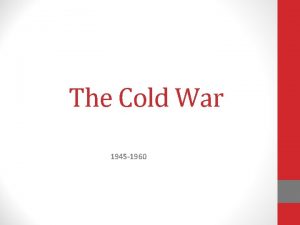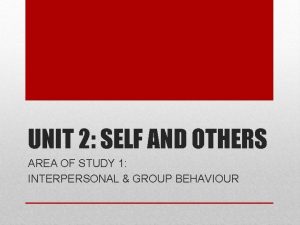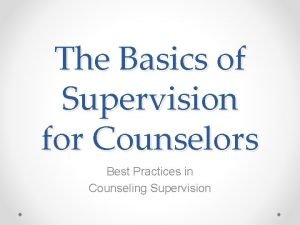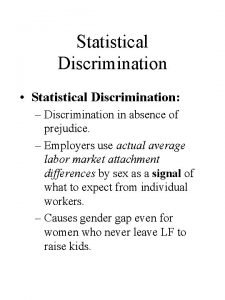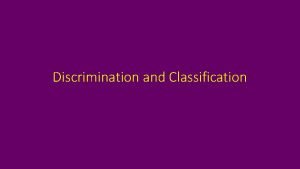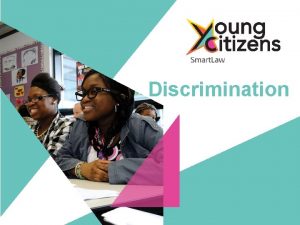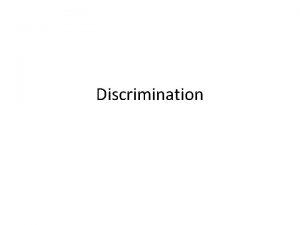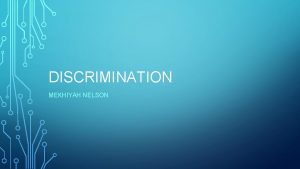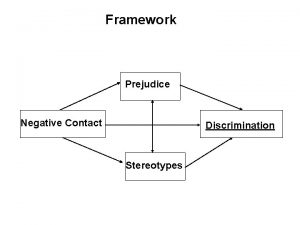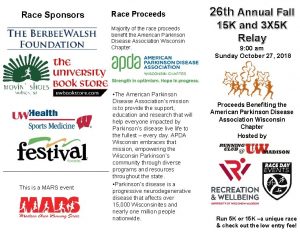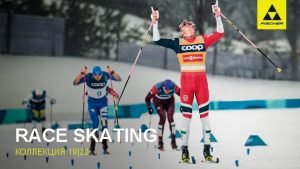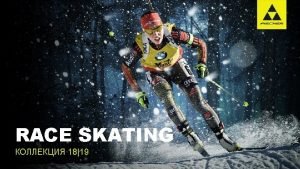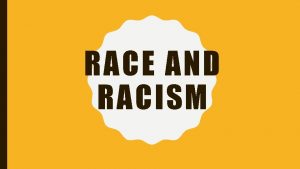RACE PART 2 Causes of discrimination 3 theories





















- Slides: 21

RACE PART 2 • • • Causes of discrimination 3 theories Article Robert Merton How the concept of race started Test 2 next class (study guide on website, bring scantron and pencil, be on time) “Everything that happens to you is your teacher. The secret is to learn to sit at the feet of your own life and be taught by it. ” – Polly B. Berends, author

Stereotypes Preconceived, simplistic idea about the members of a group Hinder social interactions, lead to false assumptions Vandalism part 1 4: 30 Vandalism in park

How was assignment #5 graded? 4 Strong understanding of theory demonstrated (you correctly points explain theory and exactly how you feel it connects to the crime) 3 Summary of crime includes important details (who, what, points where, when) 1 Sources provided (News source and date of crime included in point APA or MLA format, class notes cited as well) 2 Grammar, spelling, and punctuation correct. points Total possible: 10 points

Sources of prejudice and discrimination Sociological and Psychological Perspectives Causes of prejudice can be grouped into 4 categories. 1) Cultural Transmission 2) Group Identification Theory 3) Personality theories 4) Frustration-aggression hypothesis

Sources of prejudice and discrimination Cultural Transmission: prejudice transmitted through culture stereotypes from generation to generation. prejudice • child learns prejudice • stereotyping (by family, peers, media) • social distance-extent of contact members of one group allow or desire with others

Sources of prejudice and discrimination 2) Group Identification Theory: prejudices are tied in with group membership. • groups are drawn together through common interests • “in-group” tend to rate others as lower • Pride in your group becomes excessive

Sources of prejudice and discrimination 3) Personality theories: authoritarian personalities have higher tendencies of holding prejudice beliefs. Authoritarian personality: Ø rigidly conventional Ø uncritical of authority Ø preoccupied with power Ø close-minded Ø raised by excessively harsh adults leads to intolerant views of other groups

Sources of prejudice and discrimination 4) Frustration-aggression hypothesis: prejudice develops in response to people’s need to cope with the frustration in their daily lives. Ethnic groups provide scapegoats for hostility and frustration Shifting of blame

Which of these do you think best explains racism? Why? 1) Cultural Transmission: prejudice is transmitted through culture from generation to generation through family and/or media. 2) Group Identification Theory: prejudices are tied in with an individual’s racial and ethnic group membership. 3) Personality theories: those with authoritarian personalities have higher tendencies of holding prejudice beliefs. 4) Frustration-aggression hypothesis: ethnic prejudices develop in response to people’s need to cope with the frustration in their daily lives.

Team 1 Turcios Ashley Laureano Randall Mirzaei Maryam Pais Marleny Torres Juneli Team 4 Renteria Andrea Orr Karla Lim Woojoo Rivera Michael Pazos Dafna Team 7 Noh Hyunji Borojevich Evana Chavez Villegas Judith Jiang Wei Perez Daniel Team 2 Gonzales Alexis Ruiz Nesly Park Hee Won Hernandez Daisy Moreno Jesus Team 5 Mc. Gowan Hunter Torres Hector Li Shangyuan Farias Yoselin Gomez Daniel Team 8 Arana Aura Martin Aaron Reyes Mayra Hakim Reem Salinas Keny Team 3 Hernandez Stephen Overs Lauren Yashou Vera Lee Samantha Alshehabi Munira Team 6 Dunkerley Michelle Ruiz-Esparza Nayeli Skorzanka Natasha Toyama Shiho Vaja Jennifer Team 9 Rosales Juan Abdelaziz Michael Mc. Namara Brooke Jiang Yan Salazar Roxana Team 10 Stenton Fiona Yao Jinhao Contreras Antonia Romero Vanessa

Team 1 Munoz Christopher Murillo Eluterio Leon Maria Aranda Jasmine Martinez Diana Team 4 Filio Joana Nguyen Charles Dumayas Geraldin Joy Chan Felix Smith Adam Team 7 Rogers Ronnisha Perez Jennifer Pak Jessica Ramirez Claudia Miyaji Taishi Team 2 Garrett Andrea Lee Derek Cha Hanne Green Dynasty Yoshida Sarah Team 5 Kim Sara Yoshida John Muhammad Gabrielle Garcia Luis Padilla Kevin Team 8 Hernandez Guadalupe Team 11 Medina Juwina Farmer Brittani Amaya Sara Flores Evelyn Villa Arturo Colbert Lindsey Yasumura Kyle Arellano Vincent Team 3 Barril Alaina Yamada Mawusineferti Isikter Baris Rodriguez Barbara Givens Kheri Team 6 Ruiz Kevin Umanzor Jasmine Rodriguez Maritza Perez Haydee Trujillo Osmar Team 9 Alvarado Humberto Song Hee Guzman Genevieve Alvarez Javier Salvatierra Marisol Team 10 Monarres Ivonne Silvestre Katherine Realegeno George Nunez Raven

Front of room Team 1 Park Giho Martin Valorie Rein Joannelyn Quintana Alejandra Udan Neal Shayne Team 4 Griffin Janae Blum Gaye Ancheta Jonathan Brentner Kelly Shimotani Brennan Team 7 Kamigawara Yumiry Morgan Jenna Glavis Kristine Hurtado Michael Jung Yungyeong Team 2 Rodriguez Patsy Rice Matthew Linares Cristian Searles Melanie Johnson Shanon Team 5 Marquez Mayra Rios Lady Axe Jamie Segovia Marlon Saucedo Mayra Team 8 Cartagena Katherine Castillo Corey Noda Kyoko Fujimoto Reid Des Rosiers Karlee Team 3 Umetsu Steven Gonzalez Alexandra Bishop Corey Martinez Dulce Nabor Isabel Team 6 Solorzano Anthony Kang Chungyeon Doyle Justin Aguilar Karina Tsyplakov Andrey Team 9 Robinson Kelvin Marin Jessica Pelkie Adam Cicilia Francisco Kwon Dong Door Back of room Computer Team 10 Watson Donnail Rodriguez Fabian Calimquim Vanessa Lara Pedro Latham Amber

Which of these do you think best explains racism? Why? 1) Cultural Transmission: prejudice is transmitted through culture from generation to generation through family and/or media. 2) Group Identification Theory: prejudices are tied in with an individual’s racial and ethnic group membership. 3) Personality theories: those with authoritarian personalities have higher tendencies of holding prejudice beliefs. 4) Frustration-aggression hypothesis: ethnic prejudices develop in response to people’s need to cope with the frustration in their daily lives.

Guidelines for discussing race and ethnic relations: 1. Respect. 2. Respect each other’s viewpoints. 3. Allow everyone to complete their statements before responding. 4. Remember not to make generalizations or stereotypical comments about groups (racial, ethnic, religious, or other)

Article- White Privilege Discuss: 1. Which situations did you not understand? 2. Which do you think still exist? 3. Which do you think have improved greatly? 4. Have you ever received an advantage over others?

3. If I should need to move, I can be pretty sure of renting or purchasing housing in an area which I can afford and in which I would want to live. 4. I can be pretty sure that my neighbors in such a location will be neutral or pleasant to me. 5. I can go shopping alone most of the time, pretty well assured that I will not be followed or harassed. 6. I can turn on the television or open to the front page of the paper and see people of my race widely represented. 7. When I am told about our national heritage or about "civilization, " I am shown that people of my color made it what it is. 8. I can be sure that my children will be given curricular materials that testify to the existence of their race. 9. If I want to, I can be pretty sure of finding a publisher for this piece on white privilege. 11. Whether I use checks, credit cards or cash, I can count on my skin color not to work against the appearance of financial reliability. 12. I do not have to educate my children to be aware of systemic racism for their own daily physical protection. 13. I am never asked to speak for all the people of my racial group. 15. If a traffic cop pulls me over I can be sure I haven't been singled out because of my race. 16. I can easily buy picture books, dolls, toys and children's magazines featuring people of my race. 18. I can worry about racism without being seen as self-interested or self-seeking. 20. I can easily find academic courses and institutions which give attention only to people of my race. 22. I can choose blemish cover or bandages in "flesh" color and have them more or less match

Robert Merton’s Typology prejudice and discrimination do not always occur together 1. All weather liberal: unprejudiced non-discriminator 2. Fair weather liberal: unprejudiced discriminator (if in a setting where others discriminate may also discriminate) 3. Timid bigot: prejudice non-discriminator 4. All weather bigot: prejudice discriminator

• View: Questions of Race, Race is History While watching, take notes on the question: How did the concept of race begin? 1: 37 -4: 45, 12: 00 -21: 00

Individual or Institutional? Which type is more difficult to get rid of? Why? Individual: behavior by an individual that leads to unequal treatment Institutional: arrangements, practices that tend to favor one group procedures that result in unequal treatment or opportunities

Solutions: Freedom Riders 1960’s White and Black civil rights activists that worked together to end segregation Freedom Riders Documentary Extra Credit Warning: extremely offensive language used Trailer

Next class • Next class: Test 2 • study guide on website • Chapters 5, 6, 8, 13
 Race-based discrimination occurs when _____.
Race-based discrimination occurs when _____. Volkelt empathy theory
Volkelt empathy theory Data race vs race condition
Data race vs race condition Reaction and impulse turbine difference
Reaction and impulse turbine difference A solid barrier constructed at a suitable location
A solid barrier constructed at a suitable location Korean war summary
Korean war summary Proximate causation biology example
Proximate causation biology example Ultimate and proximate causes of behaviour
Ultimate and proximate causes of behaviour Addition symbol
Addition symbol Unit ratio definition
Unit ratio definition Brainpop ratios
Brainpop ratios Technical descriptions
Technical descriptions Bar parts and equipment layout
Bar parts and equipment layout The phase of the moon you see depends on ______.
The phase of the moon you see depends on ______. Part to part variation
Part to part variation Intercultural barriers to communication
Intercultural barriers to communication Direct v indirect discrimination
Direct v indirect discrimination What is discrimination
What is discrimination Bernards discrimination model
Bernards discrimination model Bernard discrimination model
Bernard discrimination model Discriminatory stimuli
Discriminatory stimuli Bernard discrimination model
Bernard discrimination model





